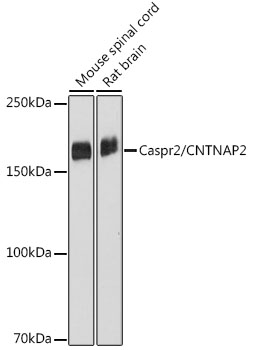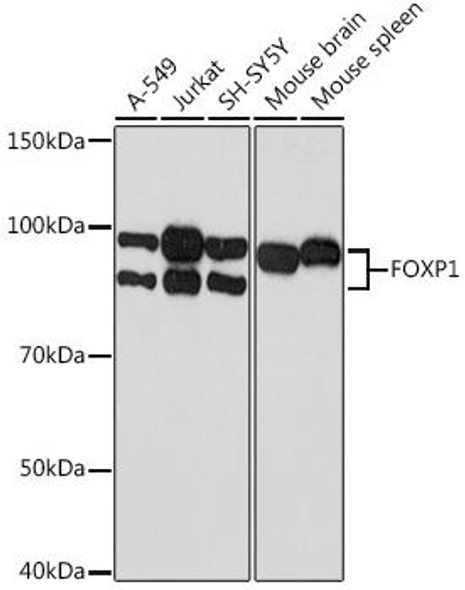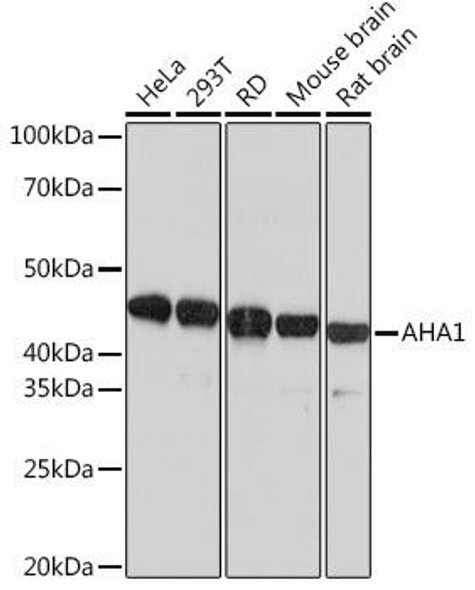Caspr2/CNTNAP2 Rabbit Monoclonal Antibody (CAB19262)
- SKU:
- CAB19262
- Product Type:
- Antibody
- Antibody Type:
- Monoclonal Antibody
- Reactivity:
- Human
- Mouse
- Rat
- Host Species:
- Rabbit
- Isotype:
- IgG
- Synonyms:
- CNTNAP2
- AUTS15
- CASPR2
- CDFE
- NRXN4
- PTHSL1
- contactin-associated protein-like 2
- Research Area:
- Cell Biology
Description
Caspr2/CNTNAP2 Rabbit Monoclonal Antibody (CAB19262)
The Anti-Caspr2 (CNTNAP2) Antibody (CAB19262) is a vital tool for researchers studying Caspr2, a cell adhesion molecule that plays a crucial role in the organization of axonal domains at nodes of Ranvier in the nervous system. This antibody, produced in rabbits, demonstrates high specificity for human samples and has been validated for use in various applications including immunohistochemistry and Western blot.Caspr2, also known as Contactin-associated protein-like 2, is essential for the proper functioning of neurons and is implicated in neural development and function.
Dysregulation of Caspr2 has been linked to neurological disorders such as autism and epilepsy, making it a promising target for understanding and potentially treating these conditions. By utilizing the Anti-Caspr2 (CNTNAP2) Antibody (CAB19262), researchers can investigate the role of Caspr2 in neurological disorders and potentially develop new therapies to target this molecule.
| Product Name: | Caspr2/CNTNAP2 Rabbit Monoclonal Antibody |
| SKU: | CAB19262 |
| Size: | 20uL, 100uL |
| Isotype: | IgG |
| Host Species: | Rabbit |
| Reactivity: | Mouse,Rat |
| Immunogen: | A synthetic peptide corresponding to a sequence within amino acids 1232-1331 of human Caspr2/CNTNAP2 (Q9UHC6). |
| Sequence: | HLDH LDSA SADF PYNP GQGQ AIRN GVNR NSAI IGGV IAVV IFTI LCTL VFLI RYMF RHKG TYHT NEAK GAES AESA DAAI MNND PNFT ETID ESKK EWLI |
| Tested Applications: | WB ELISA |
| Recommended Dilution: | WB,1:500 - 1:1000 |
| Synonyms: | CDFE; NRXN4; AUTS15; CASPR2; PTHSL1; Caspr2/CNTNAP2 |
| Positive Sample: | Mouse spinal cord,Rat brain |
| Conjugate: | Unconjugated |
| Cellular Localization: | Cell projection, Membrane, Single-pass type I membrane protein, axon. |
| Calculated MW: | 148kDa |
| Observed MW: | 152kDa |
This gene encodes a member of the neurexin family which functions in the vertebrate nervous system as cell adhesion molecules and receptors. This protein, like other neurexin proteins, contains epidermal growth factor repeats and laminin G domains. In addition, it includes an F5/8 type C domain, discoidin/neuropilin- and fibrinogen-like domains, thrombospondin N-terminal-like domains and a putative PDZ binding site. This protein is localized at the juxtaparanodes of myelinated axons, and mediates interactions between neurons and glia during nervous system development and is also involved in localization of potassium channels within differentiating axons. This gene encompasses almost 1.5% of chromosome 7 and is one of the largest genes in the human genome. It is directly bound and regulated by forkhead box protein P2, a transcription factor related to speech and language development. This gene has been implicated in multiple neurodevelopmental disorders, including Gilles de la Tourette syndrome, schizophrenia, epilepsy, autism, ADHD and intellectual disability.
| Purification Method: | Affinity purification |
| Gene ID: | 26047 |
| Clone Number: | ARC2430 |
| Storage Buffer: | Store at -20℃. Avoid freeze / thaw cycles.Buffer: PBS with 0.02% sodium azide,0.05% BSA,50% glycerol,pH7.3. |











